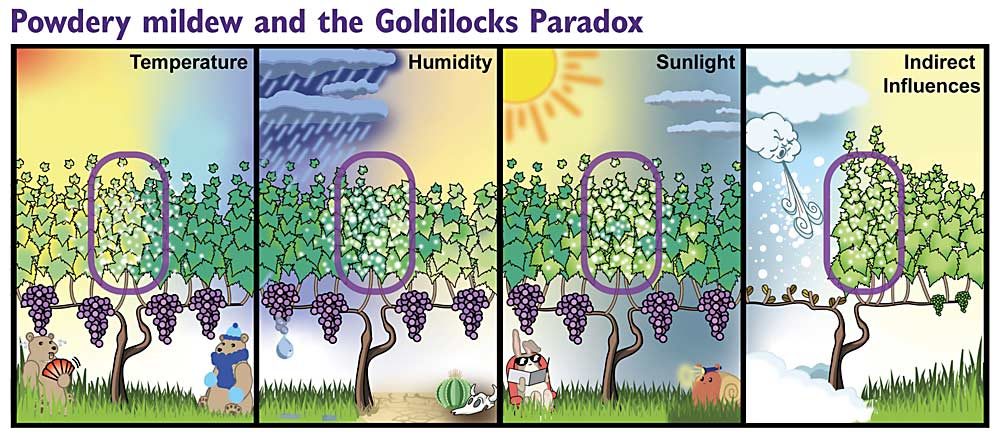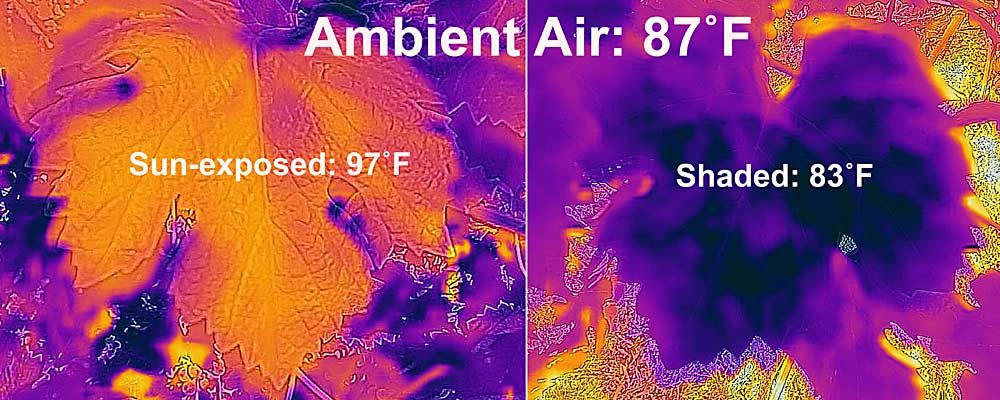Across the country, early winter marks the time for reflection on the recent vintage in preparation for the next. For many grape growers, reflection on 2019, and other recent vintages, will likely include an evaluation of the efficacy of their chosen disease management program.
Specifically for powdery mildew, a common question that arises is: “Did I have a hard time with powdery mildew management because it was a high-pressure year?”
But what factors characterize a “high-pressure” vintage? For grape powdery mildew, it means the environment was highly conducive for fungal growth and inoculum buildup.
Many aspects of the powdery mildew life cycle are driven by responses to temperature, humidity and solar radiation, and indirectly driven by how vine growth can influence these factors in the canopy.
An understanding of how these factors interact to influence fungal development and spread will help in developing effective management strategies, even under the most challenging of years.
There are a few key traits about the fungus that help us understand disease pressure.
First, greater than 95 percent of fungal growth is on the plant tissue surface, meaning it is highly exposed to the ambient environment. Second, the fungus can only grow on living, green tissue. Finally, there are two main ways the disease can become established in the vineyard: overwintering in dormant buds or as chasmothecia.
When overwintering in dormant buds, those infected buds emerge as shoots already covered with the powdery mildew fungus. Buds are infected midsummer the previous growing season and quickly establish hot spots of disease in the following season. This phenomenon is more common in regions that experience mild winters, but hard freezes in the Midwest and Northeastern states generally kill the fungus in the buds.
Chasmothecia can survive cold winters and are the primary source of the fungus in all growing regions in the United States. These ball-like structures form in the summer and fall of the previous season and are washed from leaves, shoots, clusters and tendrils onto the bark of the grapevine cordon or trunk heads and release spores the following spring when rain, heavy fog or heavy dew saturates the bark.
After the initial infection is established, in-season the disease progresses through the clonal spread of spores. Spores have everything they need to infect the plant, but if they cannot infect a plant in approximately 24 hours, the spores die and the disease will not progress. The environment plays a huge role in how long it takes for a spore to infect the plant and can drastically impact how quickly or successfully powdery mildew becomes established each season.

Temperature
The grape powdery mildew fungus response to temperature follows the Goldilocks principle: It does not like temperature extremes, but when things are “just right,” it grows rapidly.
For the fungus, temperatures below 43 degrees Fahrenheit and above 93 degrees can delay powdery mildew development, and more extreme conditions can even kill the fungus. Optimal temperatures for fungal infections to occur are between 50 and 90 degrees, with the maximum number of infections (i.e. shortest generation time) occurring at about 81 degrees.
Leaf temperature varies due to the level of exposure to sunlight, and this influences where powdery mildew infections may be located. Factors such as site elevation, plant water status (and transpiration rate), and canopy architecture (density and shading) affect vine growth and leaf temperature, and indirectly affect powdery mildew development.
Lower-lying, high-vigor and shady areas of a vineyard block are favorable for the fungus.
In the West, the response of the fungus to temperature is a main player behind spray program adjustments. In both inland and coastal areas, cold spring nights delay initial disease development.
In inland areas, midsummer disease development is also slowed by high daytime temperatures coupled with high sunlight exposure.
In growing regions with little cloud cover, powdery mildew is rarely found on the upper side of the leaf surface, due to increased leaf surface temperature.
In coastal areas, the marine cloud cover slows disease in cool regions where leaf temperatures are not warmed up to optimal temperature ranges, while that same cloud coverage accelerates disease in warm regions.
The powdery mildew situation in the Southeast, Northeast and Midwest is less predictable than in western regions, due to significant fluctuations throughout the spring and summer in both temperature, moisture and sunlight exposure.
Nighttime temperatures throughout the spring and summer are generally optimal for infections, and though the Southeast in particular can be very hot in the summer, daytime temperatures rarely exceed 93 degrees where most powdery mildew-susceptible vines are grown.
Rainfall and cloud cover contribute to powdery mildew disease development through evaporative cooling and reduced leaf and air temperatures. As such, powdery mildew is often found on the upper side of the leaves.
In all regions, the caveat for considering temperature impacts is the need to adjust for the impacts of canopy development: The denser the canopy, the more likely the interior of that canopy is shaded and is significantly cooler than external canopy temperatures.
Humidity
The powdery mildew fungus is unique in that, unlike other fungi, its spores do not need dew or rain to germinate. Humidity, however, does play a role in infection and disease development by influencing how quickly spores lose water during germination.
When temperatures are ideal, humidity below 60 percent or above 90 percent can reduce spore germination. But the vine canopy can influence the humidity levels experienced by the fungus.
When a canopy is dense or the vine is well-watered, the humidity in and immediately around the canopy is increased. This is why canopy management — which increases airflow through the canopy and allows buffering of the internal and external canopy relative humidity — is important for reducing disease pressure.
Other site and management factors, such as overhead irrigation, actively growing cover crop or the routine presence of morning dew can also increase the humidity within a vineyard block.
Sunlight
Given that greater than 95 percent of the fungus is exposed on the plant surface and lacks any pigmentation to help protect it from the sun, it is extremely susceptible to ultraviolet light (UV) damage. The impact of natural UV exposure is enhanced by radiative heat it generates.
Across all U.S. growing regions, increased sunlight penetration into the canopy improves powdery mildew management.

In warmer climates, and those regions of higher latitude and longer summer days, this effect carries a significant contribution to powdery mildew disease control. It reduces the total number of seasonal sprays needed in both conventional and organic systems.
Cloud cover common to the Northeast and the Midwest growing regions dampens the effect of UV light damage and leaf surface temperature.
In regions with high ambient humidity and lower sun angle during the growing season (Southern U.S.) the impact of natural UV light on slowing disease development is dampened.
Indirect influences
Canopy architecture and management influence the environmental conditions in and immediately around a vine, making it a critical component of powdery mildew management. Canopy management is often easier in irrigated areas of the West; in the Southeast and Midwest, canopy management can be difficult due to vine vigor.
Another factor, which is often forgotten, is vineyard layout. Row and vine spacing and their effects on vine balance, canopy management and canopy architecture can influence relative humidity, sunlight exposure, day and nighttime canopy temperatures and temperature variation within a canopy.
Tighter vine spacing can reduce airflow through the vineyard, increase relative humidity and decrease solar radiation. Vines that are tightly spaced also typically require multiple hedging passes, promoting the growth of laterals and susceptible leaf tissue.
While activities such as shoot thinning, leaf removal and irrigation strategies can influence the canopy architecture, there are also out-of-season environmental factors to consider. For example, cold and precipitation during the dormant season can influence canopy development the following season.
In many northern climates with cold winters and other areas prone to early-fall and late-spring frosts, cold damage to primary and secondary buds can significantly alter canopy growth the following season.
When grapevine primary buds are damaged, secondary and tertiary buds are more likely to push. This can result in an unexpectedly large number of shoots creating a dense, powdery mildew-favorable environment.
Heavy winter and late-spring precipitation can have a similar effect by promoting rapid early season shoot growth that favors the excessive development of summer lateral shoots. A well-watered vine also has cooler leaf temperatures than a water-stressed vine, due to transpiration.
Management
When disease pressure is high, so is the risk of mismanaging fungicide applications. If spray intervals are stretched, coverage is poor or fungicide applications are rinsed off due to precipitation, the fungus has a chance to build up between sprays. This increases the likelihood that a subsequent spray could select for naturally occurring fungicide-resistant powdery mildew in that growing population.
In contrast, spray intervals are sometimes shortened to below the recommended interval during high-pressure years, with the thought that increasing applications will result in better disease control. While this might work temporarily, having more applications within a season can make it difficult to practice proper fungicide rotation.
Overuse of the same fungicide groups within a growing season can increase the risk of selecting for fungicide-resistant powdery mildew. When a year is high-pressure, additional tactics such as cultural management practices will be absolutely necessary in addition to a continuous spray program.
While understanding what a high-pressure year means is important for disease management, it’s also important in understanding what is needed for managing fungicide-resistance development and improving fungicide stewardship.
Regardless of where you farm, understanding when high-pressure conditions are occurring in your region will assist in knowing when disease management programs need to be modified for fluctuations in pathogen development and the increased risk for fungicide-resistance selection. •
—by Michelle Moyer, Monica Cooper, Phillip Brannen, Walter Mahaffee, Melanie Lewis Ivey, Timothy Miles and Charlotte Oliver
FRAME Network
The FRAME Network is a group of scientists working on fungicide resistance in grape powdery mildew. Their efforts were recently funded by the USDA-NIFA-SCRI program under award number 2018-03375 titled “FRAME: Fungicide Resistance Assessment, Mitigation, and Extension Network for Wine, Table, and Raisin Grapes.”You can read more about the project, the team’s efforts, find general resources on fungicide resistance and specific resources on fungicide stewardship and resistance management in grape powdery mildew at: framenetworks.wsu.edu.
This column’s authors are the lead scientists working on the project.






Leave A Comment